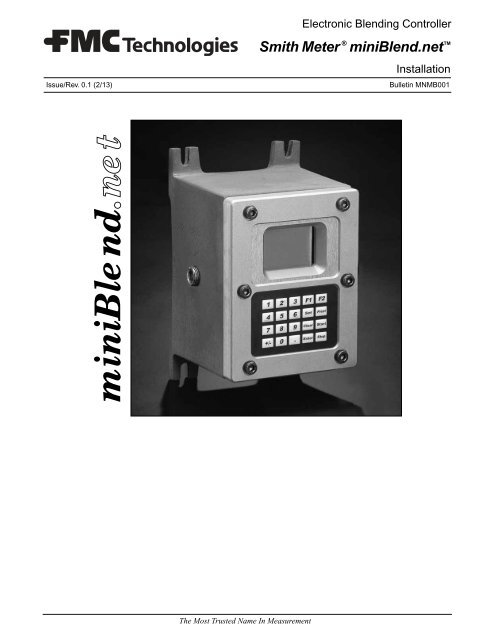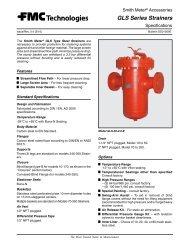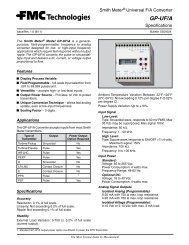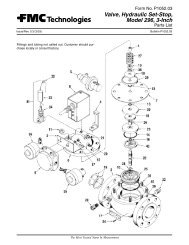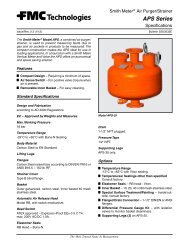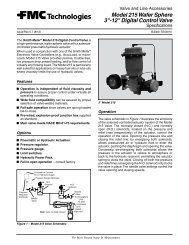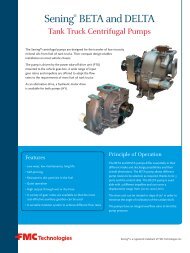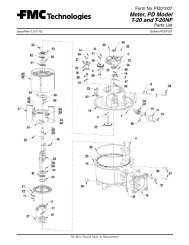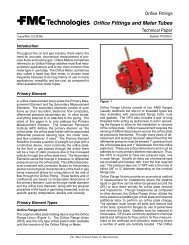download... - FMC Technologies
download... - FMC Technologies
download... - FMC Technologies
Create successful ePaper yourself
Turn your PDF publications into a flip-book with our unique Google optimized e-Paper software.
Electronic Blending Controller<br />
Issue/Rev. 0.1 (2/13)<br />
Smith Meter ® miniBlend.net <br />
Installation<br />
Bulletin MNMB001<br />
miniBlend.net<br />
The Most Trusted Name In Measurement
Caution<br />
The default or operating values used in this manual and in the program of the Smith Meter ® miniBlend.net are for<br />
factory testing only and should not be construed as default or operating values for your metering system. Each metering<br />
system is unique and each program parameter must be reviewed and programmed for that specifi c metering system<br />
application.<br />
Disclaimer<br />
<strong>FMC</strong> <strong>Technologies</strong> Measurement Solutions, Inc. hereby disclaims any and all responsibility for damages, including<br />
but not limited to consequential damages, arising out of or related to the inputting of incorrect or improper program<br />
or default values entered in connection with the miniBlend.net.<br />
Page 2 • MNMB001 Issue/Rev. 0.1 (2/13)
Receipt of Equipment<br />
When the equipment is received the outside packing case should be checked immediately for any shipping damage.<br />
If the packing case has been damaged, the local carrier should be notifi ed at once regarding his liability. Carefully<br />
remove the unit from its packing case and inspect for damaged or missing parts.<br />
If damage has occurred during shipment or parts are missing, a written report should be submitted to<br />
the Customer Service Department, <strong>FMC</strong> <strong>Technologies</strong> Measurement Solutions, Inc., 1602 Wagner Avenue, Erie,<br />
Pennsylvania 16510.<br />
Prior to installation, the unit should be stored in its original packing case and protected from adverse weather conditions<br />
and abuse.<br />
Caution<br />
This equipment generates, uses, and can radiate radio frequency energy and, if not installed and used<br />
in accordance with this Instruction Manual, may cause interference to radio communications. It has not<br />
been tested to comply with the limits for a Class A computing device pursuant to Subpart J of Part 15 of<br />
FCC Rules, which are designed to provide reasonable protection against such interference when operated in<br />
a commercial environment. Operation of this equipment in a residential area is likely to cause interference,<br />
in which case the user, at his own expense, will be required to take whatever measures may be required to<br />
correct the interference.<br />
Warning<br />
These preset devices must be used with fail-safe backup equipment to prevent accidental runaway delivery<br />
of product. Failure to provide backup equipment could result in personal injury, property loss and equipment<br />
damage.<br />
Warning<br />
On initial power-up of a new unit or after installation of a new computer board, there are several alarms that will be<br />
triggered, which cannot be cleared until the miniBlend.net is programmed.<br />
Issue/Rev. 0.1 (2/13) MNMB001 • Page 3
Table of Contents<br />
Section I – Introduction .......................................................................................................................................... 6<br />
Section II – Pre-Installation Considerations .........................................................................................................7<br />
Mechanical ............................................................................................................................................................8<br />
Electrical ...............................................................................................................................................................8<br />
Section III – Installation ........................................................................................................................................10<br />
Mechanical ..........................................................................................................................................................10<br />
Electrical .............................................................................................................................................................10<br />
Start-Up ..............................................................................................................................................................11<br />
Section IV – Diagrams ...........................................................................................................................................12<br />
Dimensions .........................................................................................................................................................12<br />
MNET Board .......................................................................................................................................................14<br />
miniBlend.net I/O and Functions .........................................................................................................................16<br />
Analog Inputs ......................................................................................................................................................25<br />
Communications .................................................................................................................................................27<br />
Digital Inputs .......................................................................................................................................................32<br />
Digital Outputs .....................................................................................................................................................33<br />
MACF Board ........................................................................................................................................................35<br />
Sample Application Wiring ..................................................................................................................................36<br />
Interposing Relays ..............................................................................................................................................36<br />
Section V – Specifications ....................................................................................................................................40<br />
Accuracy .............................................................................................................................................................40<br />
Weight .................................................................................................................................................................40<br />
Electrical Inputs ...................................................................................................................................................40<br />
Electrical Outputs ................................................................................................................................................40<br />
Environment ........................................................................................................................................................41<br />
Approvals ............................................................................................................................................................41<br />
Electromagnetic Compatibility .............................................................................................................................41<br />
Communications .................................................................................................................................................41<br />
General ...............................................................................................................................................................41<br />
Serial Ports ..........................................................................................................................................................41<br />
EIA-232 (1 dedicated, 2 programmable) .............................................................................................................41<br />
EIA-485 (1 dedicated, 2 programmable) .............................................................................................................41<br />
Ethernet...............................................................................................................................................................41<br />
Section VI – Related Publications ........................................................................................................................42<br />
Page 4 • MNMB001 Issue/Rev. 0.1 (2/13)
Tables and Figures<br />
Tables<br />
Table 1. Typical Wire Sizes ....................................................................................................................................8<br />
Table 2. Maximum Cable Length and Baud Rate (EIA-232) ..................................................................................8<br />
Table 3. Maximum Cable Length and Baud Rate (EIA-485) ..................................................................................8<br />
Table 4. Wiring Checklist......................................................................................................................................10<br />
Table 5. MNET Board Terminal Assignments ......................................................................................................15<br />
Table 6. miniBlend.net I/O Confi guration Worksheet ...........................................................................................16<br />
Table 7. Promass Modeling for Single Pulse Output ............................................................................................22<br />
Table 8. Promass Modeling for Dual Pulse Output ..............................................................................................22<br />
Table 9. Wiring Termination for T-568B and T-568A .............................................................................................31<br />
Figures<br />
Figure 1. I/O Block Diagram ....................................................................................................................................7<br />
Figure 2. miniBlend.net Dimensions ......................................................................................................................12<br />
Figure 3. Opening miniBlend.net ...........................................................................................................................13<br />
Figure 4. MNET Board ..........................................................................................................................................14<br />
Figure 5. Wiring Diagram, PRIME 4 ......................................................................................................................17<br />
Figure 6. Wiring Diagram, PEX-P Transmitter Single Pulse ..................................................................................18<br />
Figure 7. Wiring Diagram, Genesis Transmitters ................................................................................................19<br />
Figure 8. Wiring Diagram, PPS Transmitters .........................................................................................................20<br />
Figure 9. Wiring Diagram, PA-6 Transmitter ..........................................................................................................21<br />
Figure 10. Wiring Diagram, Promass ......................................................................................................................23<br />
Figure 11. Wiring Diagram, Universal Pulse Transmitter (UPT) ..............................................................................24<br />
Figure 12. Wiring Diagram, Open Collector Output .................................................................................................25<br />
Figure 13. Wiring Diagram, Analog Inputs; Resistance (RTD) / 4-20mA .................................................................26<br />
Figure 14. General Wiring for Serial Communications ............................................................................................27<br />
Figure 15. Multiple miniBlend.net Serial Communications ......................................................................................28<br />
Figure 16. Promass wiring for EIA-485 Serial Communications ..............................................................................29<br />
Figure 17. miniBlend Ethernet Communications .....................................................................................................30<br />
Figure 18. DC Digital Inputs ....................................................................................................................................32<br />
Figure 19. DC Digital Outputs .................................................................................................................................33<br />
Figure 20. AC Digital Outputs ..................................................................................................................................34<br />
Figure 21. MACF Board / Instrument Power Wiring.................................................................................................35<br />
Figure 22. Sample Application AC Wiring ...............................................................................................................37<br />
Figure 23. Sample Application DC & Signal Wiring .................................................................................................38<br />
Figure 24. Sample Application Power Wiring ..........................................................................................................39<br />
Issue/Rev. 0.1 (2/13) MNMB001 • Page 5
Section I – Introduction<br />
Introduction<br />
This manual is to be used for the installation of the Smith Meter ® miniBlend.net Electronic Blending Controller with<br />
miniBlend.net firmware. The manual is divided into six sections: Introduction, Pre-Installation Considerations, Installation,<br />
Diagrams, Specifi cations, and Related Publications.<br />
“Pre-Installation Considerations” describes the areas that must be considered prior to the installation of the<br />
miniBlend.net.<br />
“Installation” describes the areas that have to be considered when installing the miniBlend.net.<br />
“Diagrams” covers dimensional outline drawings, wiring schematics, typical interconnect diagrams etc.<br />
“Specifi cations” describes the specifi cations of the miniBlend.net Electronic Preset.<br />
“Related Publications” lists the literature that is associated with the miniBlend.net.<br />
Page 6 • MNMB001 Issue/Rev. 0.1 (2/13)
Section II – Pre-Installation Considerations<br />
The Smith Meter ® miniBlend.net is a micro-processor base in-line blending electronic instrument that supports up<br />
to 12 recipes. It is confi gurable to support user applications.<br />
Pulse Input<br />
EIA-232/EIA-485<br />
Flow Meter<br />
Pulse Input<br />
EIA-232/EIA-485<br />
Supervisory<br />
Computer, SCADA,<br />
Printers, Mass Meters<br />
EIA-232/EIA-485<br />
Temperature<br />
RTD<br />
Ethernet<br />
Supervisory<br />
Computer<br />
Temperature, Pressure,<br />
or Density<br />
4-20 ma<br />
DC Digital Output<br />
miniBlend.net<br />
DC Digital Output<br />
DC Digital Input<br />
Security Switch,<br />
Remote Start, Remote<br />
Stop, Transaction<br />
Permissive, General<br />
Purpose, Recipe Select,<br />
Alarm Reset<br />
DC Digital Input<br />
DC Digital Input<br />
AC Digital Output<br />
AC Digital Output<br />
Pumps, Digital Valves,<br />
Alarm Relays,<br />
Stop Relay,<br />
General Purpose,<br />
Transaction Enabled<br />
AC Digital Output<br />
AC Digital Output<br />
Pulse Output<br />
External Totalizer<br />
Figure 1. I/O Block Diagram<br />
Issue/Rev. 0.1 (2/13) MNMB001 • Page 7
Section II – Pre-Installation Considerations<br />
An important pre-installation consideration is the selection<br />
of the ancillary equipment to be used with the miniBlend.<br />
net and how that equipment is interfaced. This manual<br />
contains a list of the I/O availability and their functions in<br />
Section IV, page 16 which will assist in the assignment<br />
of devices to the miniBlend.net various I/O positions.<br />
A sample application with wiring diagrams can also be<br />
found in Section IV of this manual.<br />
Mechanical<br />
In addition to the following, all previous warnings and<br />
cautions should be reviewed before installation.<br />
1. A solid vertical or slanted surface should be used for<br />
mounting the explosion-proof miniBlend.net housing.<br />
Weight: = 15 lb. (2.3 kg)<br />
2. The location and the height of miniBlend.net should be<br />
selected to permit easy viewing of the display and to<br />
provide convenient access to the keypad by all users.<br />
See Figure 2 for dimensions of the miniBlend.net.<br />
3. Access for servicing miniBlend.net is through the front<br />
cover. For service, wiring and removal of parts the cover<br />
must removed.<br />
4. Conduit entry to the explosion-proof miniBlend.net is<br />
both through the bottom and sides. There are two 3/4"<br />
NPT conduit entrances in the bottom of the unit<br />
and one 1/2" NPT conduit entrances in each side<br />
of the unit.<br />
5. In warm climates, miniBlend.net should be shaded from<br />
direct sunlight. The maximum external temperature<br />
of the miniBlend.net housing must not exceed 140°F<br />
(60°C) to ensure that the internal temperature limit is not<br />
exceeded.<br />
Electrical<br />
1. All DC wiring must be routed into miniBlend.net<br />
through the conduit entries located in the bottom of<br />
the housing. Do not route DC and AC wiring through<br />
the same conduit entry.<br />
2. The DC signal wires must be multi-conductor<br />
shielded cable of 18 to 24 AWG minimum stranded<br />
copper.<br />
3. Ethernet cable must meet the requirements of CAT5<br />
at a minimum. Direct Ethernet connections between<br />
computer and miniBlend.net require a crossover<br />
cable configuration. Standard direct cable confi guration<br />
is used where the miniBlend.net units are<br />
networked through a hub or switch.<br />
Note: The following recommendations are based on our knowledge<br />
of the electrical codes. The local electrical codes should be reviewed<br />
to ensure that these recommendations follow the local code. Also<br />
installation manuals of all the equipment being wired into the mini-<br />
Blend.net should be reviewed for transmission distances and wire<br />
recommendations.<br />
Table 1. Typical Wire Sizes<br />
Equipment<br />
Transmitters<br />
Temp. Probes<br />
Density and<br />
Pressure<br />
Transmitters<br />
Number and<br />
Gauge of Wire<br />
4 / 18 Ga.<br />
4 / 20 Ga.<br />
4 / 22 Ga.<br />
Belden<br />
Number or<br />
Equivalent<br />
9418<br />
8404<br />
8729<br />
OR<br />
9940<br />
EIA-232 Comm 3 / 24 Ga. 9533<br />
EIA-485 Comm 4 / 24 Ga. 9842<br />
Table 2. Maximum Cable Length and Baud Rate (EIA-232)<br />
Baud Rate Feet Meters<br />
38,400 250 75<br />
19,200 500 150<br />
9,600 1,000 305<br />
4,800 2,000 610<br />
2,400 4,000 1,220<br />
1,200 4,000 1,220<br />
Table 3. Maximum Cable Length and Baud Rate (EIA-485)<br />
Baud Rates Feet Meters<br />
1,200 to 38,400 4,000 1,220<br />
4. All AC wiring must be routed into miniBlend.net<br />
through the conduit entries located in the side of<br />
the housing. Connectors sized for a maximum of 14<br />
gauge wire, consult the local electrical codes for the<br />
minimum AC wire size required for your application.<br />
Do not route AC and DC wiring through the same<br />
conduit entry.<br />
5. All AC wiring should be stranded copper and must<br />
comply with federal, state and local codes and<br />
specifications.<br />
6. Two separate AC circuits must be provided from the<br />
breaker panel. One circuit will supply isolated power<br />
to the miniBlend.net electronics (instrument power).<br />
The second circuit will supply power to the external<br />
devices.<br />
Page 8 • MNMB001 Issue/Rev. 0.1 (2/13)
Section II – Pre-Installation Considerations<br />
7. For proper operation, the miniBlend.net must be<br />
earth grounded. The grounding point should be as<br />
close to the unit as possible. To ensure proper earth<br />
ground:<br />
a) The resistance between the earth ground lug in<br />
the miniBlend.net and the grounding point must<br />
not exceed 2 Ω.<br />
b) The proper grounding point is a ½" to ¾"<br />
diameter copper stake that extends into the<br />
water table. Where this is not practical, a ground<br />
plane may be used.<br />
Note: Electrical conduit, piping, and structural<br />
steel are not considered proper grounding<br />
points for equipment using electronics.<br />
c) No other devices, except the miniBlend.net and<br />
ancillary equipment should be connected to any<br />
point in the grounding circuit.<br />
8. All user wiring is terminated at compression-type<br />
screw terminal strips. These terminal strips may be<br />
removed from the miniBlend.net MACF and MNET<br />
circuit boards to facilitate ease of wiring. Once wiring<br />
is complete, the terminal strips are then “plugged<br />
into” their respective positions on the circuit boards.<br />
9. If external relay permissives are used in series with<br />
miniBlend.net AC digital outputs, an RC network<br />
must be placed in parallel with the permissive to<br />
prevent a false turn-on of the miniBlend.net digital<br />
outputs. Recommended RC network = 0.1 UF<br />
capacitor and a 680 Ω resistor (Electrocube part<br />
number RG 2031-11).<br />
10. Interposing relays must be installed between the<br />
pump controller, alarming device, and the mini-<br />
Blend.net permissive sense relays. Permissive<br />
sense inputs are DC voltage.<br />
Issue/Rev. 0.1 (2/13) MNMB001 • Page 9
Section III – Installation<br />
Mechanical<br />
1. Mount the miniBlend.net using four (4) 5/16 - 18 bolts.<br />
See Figure 2 for mounting hole layout.<br />
2. Attach the required conduit runs to the miniBlend.<br />
net. Be sure to plug all unused conduit entries.<br />
3. In preparation for wiring, remove miniBlend.net cover/keypad/display.<br />
This is done by removing six (6)<br />
cap screws, which hold the cover to the miniBlend.<br />
net enclosure. Carefully pull the cover away from<br />
the enclosure and unplug factory-installed cables<br />
by removing the terminal blocks at the MNET circuit<br />
board. Note the position of these connections for<br />
reinstallation later.<br />
4. Care must be taken in handling the miniBlend.net<br />
enclosure and cover to avoid scratching the ground<br />
fl ange where they are assembled.<br />
Electrical<br />
1. AC circuits must be isolated from DC circuits and<br />
brought into the unit through their respective conduit<br />
openings.<br />
ATEX / ICE Ex<br />
Cable entry must be in accordance to EN 50018:2000<br />
section 13.1.<br />
For systems utilizing cable guards, the gland and<br />
or thread adaptor must be EEx certifi ed. The cable<br />
end must be securely installed and, depending on<br />
the cable type, be properly protected from mechanical<br />
damage.<br />
Conduit entry must be in accordance to EN<br />
50018:2000 section 13.2.<br />
For systems utilizing conduit, an EEx certified sealing<br />
device must be used immediately at the entrance of<br />
the enclosure.<br />
An unused entry must be suitably blocked with an<br />
EEx certifi ed plug.<br />
Caution: To prevent ignition of hazardous atmospheres,<br />
disconnect from supply circuit before<br />
opening, keep tightly closed when circuits are in<br />
operation.<br />
Warning: Contains internal battery-powered circuit,<br />
to prevent ignition of hazardous atmospheres, do<br />
not open enclosure unless area is known to be<br />
non-hazardous.<br />
Note: Refer to page 41 for certifi cation and marking<br />
information.<br />
2. All signal and DC wiring should be connected before<br />
connecting AC wiring.<br />
3. Be sure all connections on the terminal blocks are<br />
tight.<br />
4. All exposed shields must be properly insulated to<br />
prevent short circuits to other terminals or to the<br />
chassis. The shield at the device (e.g., temperature<br />
device, transmitter, etc.) must be cut back to<br />
the insulation and taped off. All shields should be<br />
continuous. If splices are required, they must be<br />
soldered and properly insulated.<br />
If other communicating devices are used with the<br />
miniBlend.net, refer to the manual for that unit for<br />
shielding information. Shields for other communicating<br />
equipment should not be terminated in the<br />
miniBlend.net.<br />
Note: Shields must not be terminated at the earth<br />
ground lugs.<br />
5. Suffi cient slack should be provided for the wiring<br />
in the miniBlend.net to permit easy removal of the<br />
boards. With sufficient slack, the terminal blocks can<br />
be removed and laid back out of the way so that the<br />
boards can be replaced without removing individual<br />
wires.<br />
6. There is an earth ground lug provided in the unit.<br />
The wire from the lug should be connected to the<br />
proper grounding point. See Pre-Installation Considerations,<br />
page 7.<br />
Note: CENELEC approved miniBlend.nets require<br />
that the customer install ferrules (Aderendhulsen)<br />
per DIN 46 228 on the grounding wires prior to<br />
installation into the grounding lugs.<br />
7. Typical electrical installation diagrams are provided<br />
in the following sections to show the miniBlend.net<br />
and ancillary equipment. Before wiring the ancillary<br />
equipment, refer to its installation manual. Use the<br />
installation diagrams in conjunction with the following<br />
checklist to make all necessary connections to<br />
your miniBlend.net<br />
8. Reconnect all terminal blocks to their respective<br />
positions on the MACF and MNET boards. These<br />
terminals blocks are not “keyed”, therefore take<br />
extreme care to be certain that terminal blocks are<br />
returned to the correct position and are in the correct<br />
orientation.<br />
Table 4. Wiring Checklist<br />
❑ Install Pulse Input Wiring (from Meters)<br />
❑ Install Pulse Outputs Wiring<br />
❑ Install Analog Input Wiring (RTD and 4-20mA)<br />
❑ Install Communications Wiring<br />
❑ Install Digital Input Wiring (DC)<br />
❑ Install Digital Output Wiring (DC)<br />
❑ Install Digital Output Wiring (AC)<br />
❑ Install Earth Ground<br />
❑ Install Instrument Power Wiring<br />
Page 10 • MNMB001 Issue/Rev. 0.1 (2/13)
Section III – Installation<br />
Start-Up<br />
When the wiring is completed and verifi ed, apply only<br />
instrument power to the unit. The displays should light,<br />
indicating that the miniBlend.net is ready for Start-Up.<br />
Next, the miniBlend.net must be confi gured internally<br />
to match the inputs and outputs to which it has been<br />
connected. The Operator Reference Manual provides the<br />
procedures for the complete confi guration of the mini-<br />
Blend.net. Once confi gured, check the operation of the<br />
inputs to the miniBlend.net. Next, apply external device<br />
power and check the operation of output devices. The<br />
miniBlend.net is now ready for use. The Operations<br />
Manual describes the procedures used in the day to<br />
day use of the instrument.<br />
Issue/Rev. 0.1 (2/13) MNMB001 • Page 11
Section IV – Diagrams<br />
1/2" NPT Conduit Connection<br />
1/2" NPT Conduit Connection<br />
7.36 9.65<br />
(187) (245)<br />
3.69<br />
(94)<br />
3.69<br />
(94)<br />
2.50<br />
(64)<br />
2.50<br />
(64)<br />
Two (2) 3/4" NPT Conduit Connection<br />
Mounting<br />
Hole<br />
Layout<br />
8.63<br />
(219)<br />
2.50<br />
(64)<br />
5.70<br />
(145)<br />
4.75<br />
(121)<br />
2.38<br />
(60)<br />
5.75<br />
(146)<br />
Figure 2. miniBlend.net Dimensions<br />
Page 12 • MNMB001 Issue/Rev. 0.1 (2/13)
Section IV – Diagrams<br />
Figure 3. Opening miniBlend.net<br />
Issue/Rev. 0.1 (2/13) MNMB001 • Page 13
Section IV – Diagrams<br />
Figure 4. MNET Board<br />
Switch “S2” Functions<br />
Switch 1: Reserved (must be OFF)<br />
Switch 2: ON activates fi rmware upgrade on power up<br />
Switch 3: See below<br />
Switch 4: See below<br />
Switch 5: ON resets security password on power up Switch 6: Reserved (must be OFF)<br />
Note: Factory setting for all S2 switches is OFF<br />
Switch 3 Switch 4 Function<br />
OFF OFF No effect, program values used<br />
ON OFF Forces IP address to 192.168.0.1<br />
OFF ON Forces IP address to 10.0.0.1<br />
ON ON Enables DCHP<br />
Switch “S1” Functions (RS-485 termination)<br />
Position 1 Position 2 Position 3 Position 4 Position 5 Position 6<br />
COM1 COM1 COM2 COM2 COM3 COM3<br />
Setting is OFF for RS-232 and ON for the last unit in the RS-485 communication line.<br />
Note: Factory settings for all positions of “S1” is OFF<br />
Page 14 • MNMB001 Issue/Rev. 0.1 (4/12)
Section IV – Diagrams<br />
Table 5. MNET Board Terminal Assignments<br />
Connector: CN1<br />
Terminal # Description 232 485<br />
1 COM2 232Tx 485Tx-<br />
2 COM2 485Tx+<br />
3 COM2 232Rx 485Rx+<br />
4 COM2 485Rx-<br />
5 Common<br />
6 COM3 232Tx 485Tx-<br />
7 COM3 485Tx+<br />
8 COM3 232Rx 485Rx+<br />
9 COM3 485Rx-<br />
10 Common<br />
Connector: CN2<br />
Terminal # Description 232 485<br />
1 COM1 232Tx 485Tx-<br />
2 COM1 485Tx+<br />
3 COM1 232Rx 485Rx+<br />
4 COM1 485Rx-<br />
5 Common<br />
Terminal #<br />
1 RTD +<br />
2 SIG +<br />
3 SIG -<br />
4 RTD -<br />
5 Shield<br />
Terminal #<br />
1 Input (DC) #1 +<br />
2 Input (DC) #1 -<br />
3 Input (DC) #2 +<br />
4 Input (DC) #2 -<br />
5 Input (DC) #3 +<br />
6 Input (DC) #3 -<br />
7 Pulse Out +<br />
8 Pulse Out -<br />
Connector: CN3<br />
Description<br />
Connector: CN4<br />
Description<br />
Terminal #<br />
Connector: CN5<br />
Description<br />
1 Meter Pulse Input/Channel A +<br />
2 Meter Pulse Input/Channel A -<br />
3 Factory Use Only - Do not connect<br />
4 Factory Use Only - Do not connect<br />
5 Shield<br />
6 Meter Pulse Input/Channel B/Metered Inj +<br />
7 Meter Pulse Input/Channel B/Metered Inj -<br />
8 Factory Use Only - Do not connect<br />
9 Factory Use Only - Do not connect<br />
10 Shield<br />
11 Output (DC) #1 +<br />
12 Output (DC) #1 -<br />
13 Output (DC) #2 +<br />
14 Output (DC) #2 -<br />
Terminal #<br />
Connector: CN6<br />
Description<br />
1 Factory Cable to MACF (DC PW R +)<br />
2 Factory Cable to MACF (Common)<br />
3 Factory Cable to MACF (+12 Vdc Transmitter) power<br />
4 Factory Cable to MACF (Common)<br />
5 Factory Cable to MACF (Earth/Enclosure Gnd)<br />
Terminal #<br />
1 AC Output Common<br />
2 N.C.<br />
3 Output (AC) #6<br />
4 Output (AC) #5<br />
5 Output (AC) #4<br />
6 Output (AC) #3<br />
Terminal #<br />
Connector: CN7<br />
Description<br />
Connector: CN8<br />
RJ-45 Ethernet Port<br />
Connector: CN9<br />
Description<br />
1 4-20mA input +<br />
2 Return . - (Common)<br />
Note: Electronically connected to common<br />
Connector: CN15<br />
Factory Cable to MACF (CN1)<br />
Issue/Rev. 0.1 (2/13) MNMB001 • Page 15
Section IV – Diagrams<br />
miniBlend.Net I/O Availability and Functions<br />
The following is a list of the Inputs and Outputs available in the miniBlend.Net along with associated Function<br />
options as applicable:<br />
Meter pulse Inputs: Quantity (2)<br />
Meter Pulse Input A: Used for the Blend Stream Meter<br />
Meter Pulse Input B: Used for the Wild Stream Meter<br />
DC Pulse Output: Quantity (1)<br />
Programmable for the Blend, Wild or Combined Stream meter pulses<br />
DC Digital Inputs: Quantity (3)<br />
Selectable Functions available:<br />
Transaction Permissive<br />
Security<br />
Recipe Select #1<br />
Recipe Select #2<br />
Recipe Select #3<br />
Remote Start<br />
Remote Stop<br />
Alarm Reset<br />
General Purpose Input<br />
Digital Outputs: Quantity (2) DC, and (4) AC<br />
Selectable Functions available:<br />
Pump<br />
Upstream Solenoid<br />
Downstream Solenoid<br />
Alarm Relay #1<br />
Alarm Relay #2<br />
General Purpose Output<br />
Stop Relay<br />
Transaction Enabled<br />
Analog Inputs:<br />
Quantity: (1) RTD Programmable for the Blend or Wild Stream or Shared<br />
Quantity: (1) 4-20mA Programmable for the Blend or Wild or Stream or Shared<br />
Selectable Functions available:<br />
Temperature<br />
Pressure<br />
Density<br />
Communication Ports:<br />
Quantity: (1) Ethernet for Host Control<br />
Quantity: (3) Serial Communications: RS232 or RS84<br />
Selectable Functions available:<br />
Host Control<br />
Printer<br />
Promass mass meter<br />
Page 16 • MNMB001 Issue/Rev. 0.1 (2/13)
Section IV – Diagrams<br />
Note: Blend Stream Meter must be connected to the “A” Pulse Input on the MNET board, while the Wild Stream Meter must be connected to<br />
the “B” Pulse Input.<br />
PRIME 4<br />
CN5<br />
MNET Board<br />
CN5<br />
MNET Board<br />
WHITE<br />
BLACK<br />
RED<br />
YELLOW<br />
1 A+<br />
2 A-<br />
3<br />
4<br />
5 Shield<br />
6 B+<br />
1 A+<br />
2 A-<br />
3<br />
4<br />
5 Shield<br />
6 B+<br />
7 B-<br />
8<br />
9<br />
10<br />
11<br />
12<br />
13<br />
14<br />
PRIME 4<br />
WHITE<br />
BLACK<br />
RED<br />
YELLOW<br />
7 B-<br />
8<br />
9<br />
10<br />
11<br />
12<br />
13<br />
14<br />
CN6<br />
CN6<br />
1<br />
1<br />
2<br />
2<br />
3 +12Vdc<br />
3 +12Vdc<br />
4 Gnd<br />
4 Gnd<br />
5<br />
5<br />
PRIME 4, Blend Stream Meter<br />
PRIME 4, Wild Stream Meter<br />
Figure 5. Wiring Diagram PRIME 4<br />
PRIME 4 Wire Codes:<br />
Black: Common<br />
Red: +12 Vdc<br />
White: Signal A<br />
Yellow: Signal B<br />
Note:<br />
The pulse input circuitry has 1.6 kΩ of current limiting resistance “built-in” so that an external pull-up resistor is not required when an open collector<br />
output device is connected as shown.<br />
Issue/Rev. 0.1 (2/13) MNMB001 • Page 17
Section IV – Diagrams<br />
Note: Blend Stream Meter must be connected to the “A” Pulse Input on the MNET board, while the Wild Stream Meter must be connected to<br />
the “B” Pulse Input.<br />
PEX-P<br />
CN5<br />
MNET Board<br />
PEX-P<br />
CN5<br />
MNET Board<br />
BLACK<br />
WHITE<br />
RED<br />
1 A+<br />
2 A-<br />
3<br />
4<br />
BLACK<br />
WHITE<br />
RED<br />
1 A+<br />
2 A-<br />
3<br />
4<br />
5 Shield<br />
5 Shield<br />
6 B+<br />
6 B+<br />
7 B-<br />
7 B-<br />
8<br />
8<br />
9<br />
9<br />
10<br />
10<br />
11<br />
11<br />
12<br />
12<br />
13<br />
13<br />
14<br />
14<br />
CN6<br />
CN6<br />
1<br />
1<br />
2<br />
2<br />
3 +12Vdc<br />
3 +12Vdc<br />
4 Gnd<br />
4 Gnd<br />
5<br />
5<br />
PEX-P, Blend Stream Meter<br />
PEX-P, Wild Stream Meter<br />
Figure 6. Wiring Diagram, PEX-P Transmitter Single Pulse<br />
PEX-P Wire Codes:<br />
Black: Signal<br />
Red: +12 Vdc<br />
White: Common<br />
Note:<br />
The pulse input circuitry has 1.6 kΩ of current limiting resistance “built-in” so that an external pull-up resistor is not required when an open collector<br />
output device is connected as shown.<br />
Page 18 • MNMB001 Issue/Rev. 0.1 (2/13)
Section IV – Diagrams<br />
Note: Blend Stream Meter must be connected to the “A” Pulse Input on the MNET board, while the Wild Stream Meter must be connected to<br />
the “B” Pulse Input.<br />
MNET Board<br />
MNET Board<br />
CN5<br />
CN5<br />
1 A+<br />
1 A+<br />
2 A-<br />
2 A-<br />
3<br />
3<br />
4<br />
4<br />
5 Shield<br />
5 Shield<br />
CN1<br />
6 B+<br />
6 B+<br />
1<br />
2<br />
3<br />
4<br />
5<br />
6<br />
7<br />
8<br />
7 B-<br />
8<br />
9<br />
10<br />
11<br />
12<br />
13<br />
14<br />
1<br />
2<br />
3<br />
4<br />
5<br />
6<br />
7<br />
CN1<br />
7 B-<br />
8<br />
9<br />
10<br />
11<br />
12<br />
13<br />
14<br />
CN6<br />
8<br />
CN6<br />
1<br />
1<br />
2<br />
2<br />
3 +12Vdc<br />
3 +12Vdc<br />
4 Gnd<br />
4 Gnd<br />
5<br />
5<br />
Genesis, Blend Stream Meter<br />
Genesis, Wild Stream Meter<br />
Figure 7. Wiring Diagram, Genesis PD Transmitters<br />
Genesis Terminal Connections:<br />
1. +10-30 Vdc<br />
2. “A” Signal<br />
3. “B” Signal<br />
4. Common<br />
Note:<br />
The pulse input circuitry has 1.6 kΩ of current limiting resistance “built-in” so that an external pull-up resistor is not required when an open collector<br />
output device is connected as shown.<br />
Issue/Rev. 0.1 (2/13) MNMB001 • Page 19
Section IV – Diagrams<br />
Note: Blend Stream Meter must be connected to the “A” Pulse Input on the MNET board, while the Wild Stream Meter must be connected to<br />
the “B” Pulse Input.<br />
PPS<br />
CN5<br />
MNET Board<br />
CN5<br />
MNET Board<br />
1<br />
1 A+<br />
1 A+<br />
2<br />
2 A-<br />
2 A-<br />
3<br />
3<br />
3<br />
4<br />
4<br />
4<br />
5<br />
5 Shield<br />
5 Shield<br />
6<br />
6 B+<br />
7 B-<br />
8<br />
9<br />
10<br />
11<br />
12<br />
13<br />
PPS<br />
1<br />
2<br />
3<br />
4<br />
5<br />
6<br />
6 B+<br />
7 B-<br />
8<br />
9<br />
10<br />
11<br />
12<br />
13<br />
14<br />
14<br />
CN6<br />
CN6<br />
1<br />
1<br />
2<br />
2<br />
3 +12Vdc<br />
3 +12Vdc<br />
4 Gnd<br />
4 Gnd<br />
5<br />
5<br />
PPS, Blend Stream Meter<br />
PPS, Wild Stream Meter<br />
Figure 8. Wiring Diagram, PPS Transmitters<br />
PPS Terminal Connections:<br />
1. Common<br />
2. +12 Vdc<br />
3. Signal B<br />
4. B Bar<br />
5. Signal A<br />
6. A Bar<br />
Note:<br />
The pulse input circuitry has 1.6 kΩ of current limiting resistance “built-in” so that an external pull-up resistor is not required when an open collector<br />
output device is connected as shown.<br />
Page 20 • MNMB001 Issue/Rev. 0.1 (2/13)
Section IV – Diagrams<br />
Note: Blend Stream Meter must be connected to the “A” Pulse Input on the MNET board, while the Wild Stream Meter must be connected to<br />
the “B” Pulse Input.<br />
PA-6<br />
CN5<br />
MNET Board<br />
CN5<br />
MNET Board<br />
1<br />
3<br />
5<br />
1 A+<br />
2 A-<br />
3<br />
1 A+<br />
2 A-<br />
3<br />
4<br />
5 Shield<br />
6 B+<br />
7 B-<br />
8<br />
9<br />
10<br />
11<br />
12<br />
13<br />
14<br />
PA-6<br />
1<br />
3<br />
5<br />
4<br />
5 Shield<br />
6 B+<br />
7 B-<br />
8<br />
9<br />
10<br />
11<br />
12<br />
13<br />
14<br />
CN6<br />
CN6<br />
1<br />
1<br />
2<br />
2<br />
3 +12Vdc<br />
3 +12Vdc<br />
4 Gnd<br />
4 Gnd<br />
5<br />
5<br />
PA-6, Blend Stream Meter<br />
PA-6, Wild Stream Meter<br />
Figure 9. Wiring Diagram, PA-6<br />
PA-6 Terminal Connections<br />
1: Common<br />
3: Signal<br />
5: +12 Vdc<br />
Note:<br />
The pulse input circuitry has 1.6 kΩ of current limiting resistance “built-in” so that an external pull-up resistor is not required when an open collector<br />
output device is connected as shown.<br />
Issue/Rev. 0.1 (2/13) MNMB001 • Page 21
Section IV – Diagrams<br />
Promass 80, 83, and 84<br />
When connecting the Promass 84 (does not apply to the Promass 80 or 83 models) to an miniBlend, it is important<br />
that the “Line Monitoring” function on the Promass 84 be disabled. This is because the pulse input circuitry of the/<br />
miniBlend requires the input pulse “off” voltage to be less than one volt (and the “on” voltage to be greater than 5<br />
volts). If the “Line Monitoring” on the Promass 84 is enabled, the “off” voltage of the pulses will be greater than one<br />
volt and therefore will not be counted by the miniBlend. There are three jumpers on each of the frequency output<br />
submodules on the I/O board that enable/disable the “Line Monitoring” function. The factory default is to enable “Line<br />
Monitoring”. Follow the steps from section 6.4.2 of the Proline Promass 84 Operating Instruction – Bulletin MN0M032<br />
to enable/disable this function.<br />
Use this table to determine if the Promass can be wired for single or dual pulse output and the terminal number corresponding<br />
to each unique model. The wiring diagrams are shown on the following pages.<br />
Transmitter/Sensor Modeling + Terminal - Terminal<br />
80XXX -X-XXX-X-X-X-X-X-X-X-A 24 25<br />
80XXX -X-XXX-X-X-X-X-X-X-X-D 24 25<br />
80XXX -X-XXX-X-X-X-X-X-X-X-S 24 25<br />
80XXX -X-XXX-X-X-X-X-X-X-X-T 24 25<br />
80XXX -X-XXX-X-X-X-X-X-X-X-8 22 23<br />
83XXX -X-XXX-X-X-X-X-X-X-X-A 24 25<br />
83XXX -X-XXX-X-X-X-X-X-X-X-B 24 25<br />
83XXX -X-XXX-X-X-X-X-X-X-X-S 24 25<br />
83XXX -X-XXX-X-X-X-X-X-X-X-T 24 25<br />
83XXX -X-XXX-X-X-X-X-X-X-X-C 24 25<br />
83XXX -X-XXX-X-X-X-X-X-X-X-D 24 25<br />
83XXX -X-XXX-X-X-X-X-X-X-X-N 22 23<br />
83XXX -X-XXX-X-X-X-X-X-X-X-P 22 23<br />
83XXX -X-XXX-X-X-X-X-X-X-X-2 24 25<br />
83XXX -X-XXX-X-X-X-X-X-X-X-4 24 25<br />
83XXX -X-XXX-X-X-X-X-X-X-X-5 24 25<br />
84XXX -X-XXX-X-X-X-X-X-X-X-S 24 25<br />
84XXX -X-XXX-X-X-X-X-X-X-X-T 24 25<br />
84XXX -X-XXX-X-X-X-X-X-X-X-N 22 23<br />
84XXX -X-XXX-X-X-X-X-X-X-X-D 24 25<br />
84XXX -X-XXX-X-X-X-X-X-X-X-2 24 25<br />
Table 7. Promass Modeling for Single Pulse Wiring<br />
Transmitter/Sensor Modeling + Terminal - Terminal<br />
83XXX -X-XXX-X-X-X-X-X-X-X-M 22, 24 23, 25<br />
84XXX -X-XXX-X-X-X-X-X-X-X-M 22, 24 23, 25<br />
84XXX -X-XXX-X-X-X-X-X-X-X-1 22, 24 23, 25<br />
Table 8. Promass Modeling for Dual Pulse Wiring<br />
Page 22 • MNMB001 Issue/Rev. 0.1 (2/13)
Section IV – Diagrams<br />
Promass<br />
CN5<br />
MNET Board<br />
Promass<br />
CN5<br />
MNET Board<br />
23/25<br />
22/24<br />
1 A+<br />
2 A-<br />
3<br />
4<br />
5 Shield<br />
25<br />
24<br />
23<br />
22<br />
1 A+<br />
2 A-<br />
3<br />
4<br />
5 Shield<br />
6<br />
6 B+<br />
7<br />
7 B-<br />
8<br />
8<br />
9<br />
9<br />
10<br />
10<br />
11<br />
11<br />
12<br />
12<br />
13<br />
13<br />
14<br />
14<br />
CN6<br />
CN6<br />
1<br />
1<br />
2<br />
2<br />
3 +12Vdc<br />
3 +12Vdc<br />
4 Gnd<br />
4 Gnd<br />
5<br />
5<br />
Promass, Single Pulse<br />
Promass, Dual Pulse<br />
Figure 10. Wiring Diagram, Promass<br />
Promass Wire Codes<br />
Terminal 22: +<br />
Terminal 23: -<br />
Terminal 24: +<br />
Terminal 25: -<br />
Note:<br />
The pulse input circuitry has 1.6 kΩ of current limiting resistance “built-in” so that an external pull-up resistor is not required when an open collector<br />
output device is connected as shown.<br />
Issue/Rev. 0.1 (2/13) MNMB001 • Page 23
Section IV – Diagrams<br />
Note: Blend Stream Meter must be connected to the “A” Pulse Input on the MNET board, while the Wild Stream Meter must be connected to<br />
the “B” Pulse Input.<br />
UPT<br />
CN5<br />
MNET Board<br />
CN5<br />
MNET Board<br />
7<br />
1 A+<br />
1 A+<br />
6<br />
2 A-<br />
2 A-<br />
5<br />
3<br />
3<br />
4<br />
4<br />
4<br />
3<br />
5 Shield<br />
5 Shield<br />
2<br />
6 B+<br />
6 B+<br />
1<br />
7 B-<br />
7 B-<br />
8<br />
8<br />
9<br />
UPT<br />
9<br />
10<br />
10<br />
11<br />
7<br />
11<br />
12<br />
6<br />
12<br />
13<br />
5<br />
13<br />
14<br />
4<br />
14<br />
3<br />
CN6<br />
1<br />
2<br />
1<br />
CN6<br />
1<br />
2<br />
2<br />
3 +12Vdc<br />
3 +12Vdc<br />
4 Gnd<br />
4 Gnd<br />
5<br />
5<br />
UPT, Blend Stream Meter<br />
UPT, Wild Stream Meter<br />
Figure 11. Wiring Diagram, Universal Pulse Transmitter (UPT)<br />
UPT Terminal Connections:<br />
1. Electronics Ground<br />
2. Input Power (12-24 Vdc)<br />
3. Channel “B” Output<br />
4. Channel “B” Inverse Output<br />
5. Channel “A” Output<br />
6. Channel “A” Inverse Output<br />
7. Shield<br />
8. Verifi cation Pulse Output<br />
9. Inverted Verifi cation Pulse<br />
10. Not Used<br />
Note:<br />
The pulse input circuitry has 1.6 kΩ of current limiting resistance “built-in” so that an external pull-up resistor is not required when an open collector<br />
output device is connected as shown.<br />
Page 24 • MNMB001 Issue/Rev. 0.1 (2/13)
Section IV – Diagrams<br />
Note: Blend Stream Meter must be connected to the “A” Pulse Input on the MNET board, while the Wild Stream Meter must be connected to<br />
the “B” Pulse Input.<br />
Figure 12. Wiring Diagram, Open Collector Output<br />
Note:<br />
The pulse input circuitry has a 1.6 kΩ of current limiting resistance “built-in” so that an external pull-up resistor is not required when an<br />
open-collector device is connected as shown.<br />
Issue/Rev. 0.1 (2/13) MNMB001 • Page 25
Section IV – Diagrams<br />
Note: Blend Stream Meter must be connected to the “A” Pulse Input on the MNET board, while the Wild Stream Meter must be connected to<br />
the “B” Pulse Input.<br />
Figure 13. Analog Inputs; Resistance (RTD) / 4-20mA<br />
If using two twisted pairs of wires, RTD+ and RTD- should be wired with one twisted pair. Sig+ and Sig- should be<br />
wired with another twisted pair.<br />
This input requires a four-wire connection to a platinum sensor with the following specifi cation:<br />
1. 100 Ω @ 0 Degrees Celsius.<br />
2. 0.00385 Ω / Ω / Deg. C., DIN 43760, BS1904, or IPTS 1948 Temperature Coeffi cient.<br />
The 4-20mA input is not isolated from the processor and main power (CN9-2 is electrically connected to “common”).<br />
The 4-20mA input can be programmed for the function required by the application. The analog inputs are also scaleable<br />
through the I/O Confi guration Menu of the unit. The inputs should be wired with shielded twisted pairs of wires<br />
of 18 to 24 gauge.<br />
Note: Due to the fact that the common for the 4-20mA input on the miniBlend is not isolated, you cannot connect it in series with another mini-<br />
Blend to share the 4-20mA output signal from a single device (i.e. temperature probe, density, pressure transducer). The reason for this is that<br />
if the commons for the 4-20mA inputs on the separate miniBlends have the same potential and are connected in series, one of the inputs will<br />
be by-passed and cause it to produce a zero reading. This would then give the appearance that the second 4-20mA input in the series circuit<br />
was defective.<br />
Page 26 • MNMB001 Issue/Rev. 0.1 (2/13)
Section IV – Diagrams<br />
Note: Blend Stream Meter must be connected to the “A” Pulse Input on the MNET board, while the Wild Stream Meter must be connected to<br />
the “B” Pulse Input.<br />
Figure 14. General Wiring for Serial Communications<br />
Note: The shield is to be terminated at the communications device as shown.<br />
Note: If using RS-485 refer to switch termination information on page 14.<br />
Issue/Rev. 0.1 (2/13) MNMB001 • Page 27
Section IV – Diagrams<br />
Figure 15. Multiple miniBlend.net Serial Communications<br />
The fi gure shows the typical wiring scheme for multi-drop communications between a communications device and<br />
multiple miniBlend.nets. The last miniBlend.net in a multi-drop scheme must have the Receive Terminators enabled.<br />
These terminators are asserted by placing the appropriate switches of “S1” to the “ON” position. See Page 14 for<br />
location of “S1” on the MNET board.<br />
• COM 1 Terminators: switches 1 and 2<br />
• COM 2 Terminators: switches 3 and 4<br />
• COM 3 Terminators: switches 5 and 6<br />
Note: These terminators are for EIA-485 communications only. DO NOT assert terminators for EIA-232 modes.<br />
Page 28 • MNMB001 Issue/Rev. 0.1 (2/13)
Section IV – Diagrams<br />
CN1<br />
MNET Board<br />
26<br />
Tx + / RX +<br />
27<br />
Tx - / RX -<br />
Promass<br />
1 Tx-<br />
2 Tx+<br />
3 Rx+<br />
4 Rx-<br />
5<br />
6<br />
7<br />
8<br />
9<br />
10<br />
CN2<br />
1<br />
2<br />
3<br />
4<br />
5<br />
Figure 16. Promass Coriolis Meter Communications (RS485)<br />
Programming<br />
Parameter miniBlend Promass<br />
Baud Rate 38400 38400<br />
Parity 8/No Parity/2 Stop bits No Parity, 2 Stop bits<br />
Modbus Endian Big Byte order 3-2-1-0<br />
Sequence Number 1 Address 1<br />
Mass Meter Type<br />
E&H Promass<br />
Timeout 0<br />
Transmission Mode<br />
RTU<br />
Reply Delay<br />
10mS<br />
Mode<br />
Note: Wiring example is shown on comm 2: comm 3 can be used as well.<br />
Issue/Rev. 0.1 (2/13) MNMB001 • Page 29
Section IV – Diagrams<br />
Figure 17. miniBlend.net Ethernet Communications<br />
miniBlend.net RJ-45 Terminations<br />
The miniBlend.net and the associated RJ-45 connector located in the MNET board is designed as an “Ethernet Device”.<br />
When connecting to a distributive system through an Ethernet switch/hub or wireless bridge a straight through T-568B<br />
cable is utilized. When interfacing directly to a PC a crossover cable must be utilized (i.e. a crossover cable is used<br />
only when connecting two Ethernet devices together without the use of a hub, switch and/or router).<br />
Eight conductor CAT 5 cable contains (4) four pairs of wires. Each pair consists of a solid (or predominantly) colored<br />
wire and a white wire with a stripe of the same color. These pairs are twisted together. When making up a connector,<br />
it is best for Ethernet reliability not to untwist the pairs more than ½".<br />
There are two wiring standards for these cables; T-568A and T-568B (refer to table 7 on page 22). These standards<br />
differ only in the connection sequence. Figure 15 shows a RJ-45 plug configured as a T-568B connection. The orange<br />
and green pairs are designated for 10BaseT Ethernet. The brown and blue pairs are not used in the miniBlend.net.<br />
Note: The odd pin numbers are always white with a colored stripe.<br />
Page 30 • MNMB001 Issue/Rev. 0.1 (2/13)
Section IV – Diagrams<br />
Table 9. Wiring Termination for T-568B and T-568A<br />
Color Code Abbreviation T-568B Pin T-568A Pin<br />
white w/orange stripe wht/org 1 3<br />
orange org 2 6<br />
white w/ green stripe wht/grn 3 1<br />
blue blu 4 4<br />
white w/ blue stripe wht/blu 5 5<br />
green grn 6 2<br />
white w/brown stripe wht/brn 7 7<br />
brown brn 8 8<br />
Issue/Rev. 0.1 (2/13) MNMB001 • Page 31
Section IV – Diagrams<br />
Digital Inputs<br />
The miniBlend.net is capable of providing three DC digital inputs. The inputs can be programmed as to function<br />
through the configuration directory.<br />
Figure 18. DC Digital Inputs<br />
Page 32 • MNMB001 Issue/Rev. 0.1 (2/13)
Section IV – Diagrams<br />
Digital Outputs<br />
The miniBlend.net is capable of providing two DC digital outputs and four AC digital outputs. The outputs can be<br />
programmed as to function through the confi guration directory.<br />
Figure 19. DC Digital Outputs<br />
Issue/Rev. 0.1 (2/13) MNMB001 • Page 33
Section IV – Diagrams<br />
Figure 20. AC Digital Outputs<br />
Page 34 • MNMB001 Issue/Rev. 0.1 (2/13)
Section IV – Diagrams<br />
Voltage Selector Switch<br />
Fuse<br />
TB2: Factory Cable<br />
115 Vac<br />
Customer<br />
Wiring<br />
Hot<br />
Neutral<br />
Safety Ground<br />
CN1: Factory Cable<br />
TB1: Instrument Power<br />
Voltage Selector Switch<br />
Fuse<br />
TB2: Factory Cable<br />
230 Vac<br />
Customer<br />
Wiring<br />
Hot<br />
Hot<br />
Safety Ground<br />
CN1: Factory Cable<br />
TB1: Instrument Power<br />
Figure 21. MACF Board / Instrument Power Wiring<br />
Instrument power is connected to the MACF board located inside the miniBlend.net enclosure. Be certain to select<br />
the appropriate incoming voltage on the Voltage Selector Switch (115/230) before applying power to the unit.<br />
Issue/Rev. 0.1 (2/13) MNMB001 • Page 35
Section IV – Diagrams<br />
Sample Application Wiring<br />
The following is a sample miniBlend.net confi guration.<br />
The following signals are between the miniBlend.net and Blend Stream equipment:<br />
• PD meter w/ UPT for Blend Stream meter (Meter Pulse Input A)<br />
• Serial Printer for reports<br />
• RTD Temperature sensor for the Blend Stream product<br />
• AC Output #6 for the Upstream Solenoid for the Blend Stream valve (SV-1)<br />
• AC Output #5 for the Downstream Solenoid for the Blend Stream valve (SV-2)<br />
• AC Output #4 for the Alarm with interposing Control Relay (CR-3)<br />
• DC Output #1 for Blend Stream pump with interposing Control Relay (CR-4)<br />
The following signals are between the miniBlend.net and Wild Stream meter preset, PLC, TAS or other system<br />
controller:<br />
• PD meter w/UPT for Wild Stream meter (Meter Pulse Input B)<br />
• DC Output #2 for Transaction Enabled signal with interposing Control Relay (CR-5)<br />
• DC Input #1 for Transaction Permissive signal with interposing Control Relay (CR-1)<br />
• DC Input #2 for Alarm Reset signal with interposing Control Relay (CR-2)<br />
Interposing Relays<br />
This sample illustrates the use of interposing relays in a system of this type. Interposing relays are used to ancillary<br />
equipment in order to provide contacts which may be connected to the miniBlend.net DC Inputs. Interposing relays<br />
are also used with the miniBlend.net digital outputs to provide greater load capacity needed to energize the coils of<br />
some large load devices such as pump motor starters.<br />
Page 36 • MNMB001 Issue/Rev. 0.1 (2/13)
Section IV – Diagrams<br />
120 Vac. Hot 120 Vac. Neutral<br />
Other Controller<br />
Transaction Enabled<br />
CR-5<br />
Transaction Permissive<br />
Alarm Reset<br />
Totalizer<br />
Ticket Printer<br />
Power Supply<br />
miniBlend.net<br />
TB1<br />
1<br />
2<br />
3<br />
MACF<br />
CNT<br />
1<br />
2<br />
3<br />
SV-1<br />
Upstream Solenoid Valve Blend Stream<br />
4<br />
5<br />
6<br />
CR-3<br />
SV-2<br />
Downstream Solenoid Valve Blend Stream<br />
Alarm Relay<br />
CR-3<br />
MNET<br />
CR-4<br />
MS-1<br />
Pump Blend Stream<br />
Figure 22. Sample Application AC Wiring<br />
Issue/Rev. 0.1 (2/13) MNMB001 • Page 37
Section IV – Diagrams<br />
Blend Stream Meter with UPT<br />
miniBlend.net MNET Board<br />
7<br />
CN5<br />
CN1<br />
6<br />
1 A+<br />
Tx- 1<br />
5<br />
2 A-<br />
TX+ 2<br />
4<br />
3<br />
Rx+ 3<br />
TAS<br />
3<br />
4<br />
RX- 4<br />
1<br />
2<br />
5 Shield<br />
5<br />
2<br />
1<br />
6 B+<br />
Tx- 6<br />
3<br />
7 B-<br />
Tx+ 7<br />
4<br />
Wild Stream Meter with UPT<br />
8<br />
Rx+ 8<br />
5<br />
9<br />
Rx- 9<br />
6<br />
7<br />
CR-4<br />
10<br />
10<br />
7<br />
6<br />
11 DC Out #1+<br />
8<br />
5<br />
CR-5<br />
12 DC Out #1-<br />
9<br />
4<br />
13 DC Out #2+<br />
10<br />
3<br />
14 DC Out #2-<br />
2<br />
+ -<br />
CN6<br />
1<br />
PS<br />
1<br />
2<br />
3 +12Vdc<br />
4 Gnd<br />
TX 1<br />
CN2<br />
Printer<br />
Rx<br />
RTD Blend Stream<br />
CN3<br />
5<br />
2<br />
Rx 3<br />
Tx<br />
COM<br />
1 RTD+<br />
4<br />
SHLD<br />
2 SIG+<br />
Common 5<br />
3 SIG-<br />
4 RTD-<br />
5 Shield<br />
CN9<br />
1 4-20ma +<br />
2 4-20ma -<br />
CR-1<br />
CN4<br />
1 DC In #1+<br />
CR-2<br />
2 DC In #1-<br />
3 DC In #2+<br />
4 DC In #2-<br />
Totalizer<br />
5<br />
6<br />
+<br />
-<br />
7 Pulse Out+<br />
8 Pulse Out-<br />
SHLD<br />
Figure 23. Sample Application DC and Signal Wiring<br />
Page 38 • MNMB001 Issue/Rev. 0.1 (2/13)
Section IV – Diagrams<br />
Figure 24. Sample Application Power Wiring<br />
Issue/Rev. 0.1 (2/13) MNMB001 • Page 39
Section V – Specifi cations<br />
Specifications<br />
Accuracy<br />
Calculated Accuracy: The gross at standard temperature<br />
to gross volume ratio, excluding the accuracy of fluid temperature<br />
measurement, will exactly match the proper volume<br />
correction factor of ASTM-D-1250-04 over the fluid<br />
temperature range of -58°F to 302°F (-50°C to 150°C).<br />
Temperature Measurement Accuracy: Fluid temperature<br />
is measured to within ±0.72°F (±0.4°C) over the fluid<br />
temperature range of -328°F to 572°F (-200°C to 300°C).<br />
Fluid temperature is measured to within ±0.45°F<br />
(±0.25°C) over the fl uid temperature range of 32°F to<br />
572°F (0°C to 300°C).<br />
Stability: 0.1°F (0.06°C)/year.<br />
Flow Totalizing: Within one pulse of input frequency.<br />
Weight<br />
15 lb (2.3 kg).<br />
Electrical Inputs<br />
AC Instrument Power<br />
Switch selectable 115/230 Vac, 9W maximum, 48 to<br />
63 Hz. The AC circuitry is fuse-protected.<br />
Surge Current: 28A maximum for less than 0.1 seconds.<br />
Power Interruption Tolerance: Interruption of power<br />
greater than .05 seconds (typical) will cause an orderly<br />
shut-down of the miniBlend.net and the control<br />
valve will be immediately signaled to close.<br />
Note: A constant voltage transformer (CVT) is recommended<br />
if the available AC power is suspected not<br />
to comply with these specifications.<br />
Pulse Input<br />
Quantity: 2<br />
Type: High-speed, edge-triggered, optically isolated<br />
pulse transmitter input. The input pulse must rise<br />
above V (high min.) for a period of time and then<br />
fall below V (low) to be recognized as a pulse by<br />
miniBlend.net.<br />
V (High): 5 Vdc minimum to 28 Vdc maximum.<br />
V (Low): 1 Vdc maximum.<br />
Input Impedance: 1.6 kΩ.<br />
Pulse Resolution: 1 pulse/unit minimum, 9,999<br />
pulses/unit maximum.<br />
Input Level Duration: 83 μS minimum.<br />
Response: Within one pulse to a step change in flow rate.<br />
Mode: Single, dual, dual with power sensing, density.<br />
Duty Cycle: 35/65 to 65/35 (on/off).<br />
Temperature Probe<br />
Quantity: 1<br />
Type: four-wire, 100 Ω Platinum Resistance Temperature<br />
Detector (PRTD).<br />
Temperature Coeffi cient: @ 32°F: 0.00214 Ω / Ω / °F<br />
(0.00385 Ω / Ω / °C).<br />
Temperature Range: -148°F to 572°F (-100°C to<br />
300°C).<br />
Offset: Temperature probe offset is program-adjustable<br />
through the miniBlend.net keypad in ±0.1 degree<br />
increments in the unit of temperature measurement<br />
used.<br />
Self-calibrating: Lead length compensation that<br />
requires no resistance balancing of leads.<br />
Analog (4-20mA)<br />
Quantity: 1<br />
Type: Two-wire, 4-20mA current loop receiver, not<br />
isolated from ground, programmable as to function.<br />
Span Adjustment: Program-adjustable through the<br />
miniBlend.net keypad or communication in tenths<br />
of the unit used (negative side connected to circuit<br />
ground (common)).<br />
Input Burden: 50 Ω.<br />
Accuracy: ±0.025% of range.<br />
Resolution: One part in 1,048,576.<br />
Voltage Drop: 2 Volts maximum.<br />
Sampling Rate: One sample/300 mSec minimum.<br />
DC Inputs<br />
Quantity: 3<br />
Type: Optically-isolated solid state voltage sensors.<br />
Input Voltage Range: 5 to 28 Vdc.<br />
Pickup Voltage: 5 Vdc minimum.<br />
Drop-out Voltage: Less than 1 volt.<br />
Current at Maximum Voltage: 20mA maximum.<br />
Input Level Duration: 120 mSec minimum.<br />
Keypad<br />
Type: Membrane.<br />
Display<br />
The Graphics Display is a 128 by 64 pixel graphic<br />
Liquid Crystal Display (LCD) module with LED backlighting.<br />
Note: Units equipped with “OIML” option will have a<br />
battery backed display backlighting, estimated battery<br />
life: 2 years.<br />
Electrical Outputs<br />
DC Power<br />
12 Vdc ±10%, 180mA maximum.<br />
AC Outputs<br />
Quantity: 4<br />
Type: Optically-isolated, AC, solid-state relays. Userprogrammable<br />
as to function.<br />
Load Voltage Range: 90 to 280 Vac (rms), 48 to 63 Hz.<br />
Steady-State Load Current Range: 0.05A (rms) minimum<br />
to 1.0A (rms) maximum into an inductive load.<br />
Leakage Current at Maximum Voltage Rating: 2.5mA<br />
Page 40 • MNMB001 Issue/Rev. 0.1 (2/13)
Section V – Specifi cations<br />
(rms) maximum @ 240 Vac.<br />
On-State Voltage Drop: 2 Vac at maximum load.<br />
Maximum Output Frequency: 1 Hz<br />
DC Outputs<br />
Quantity: 2<br />
Type: Optically-isolated solid state output. Userprogrammable<br />
as to function.<br />
Polarity: Programmable (normally open or normally<br />
closed).*<br />
Switch Blocking Voltage: 30 Vdc maximum.<br />
Load Current: 150mA maximum with 0.6 Volt drop.<br />
Maximum Output Frequency: 1 Hz<br />
Note: *Power-down normally open.<br />
Pulse Output<br />
Type: Optically-isolated solid state output. Pulser<br />
output units are program-selectable through the<br />
miniBlend.net keypad or communications.<br />
Switch Blocking Voltage (Switch Off): 30 Vdc maximum.<br />
Load Current (Switch On): 10mA with 0.6 Volts drop.<br />
Frequency Range: 0 to 3000 Hz.<br />
Duty Cycle: 50/50 (on/off).<br />
Environment<br />
Ambient Operating Temperature<br />
-13°F to 140°F (-25°C to 60°C).<br />
Humidity:<br />
5 to 95% with condensation.<br />
Enclosure:<br />
Explosion-proof (NEMA 7, Class I, Groups C and D)<br />
and watertight (NEMA 4X), IP65.<br />
Approvals<br />
UL/CUL<br />
Class I, Groups C & D; Class II, Groups E, F & G<br />
Class I, Zone 1, Aex de [ib] IIB T6<br />
UL Enclosure 4X, CSA Enclosure 4<br />
ATEX<br />
EEx d [ib] IIB T6<br />
DEMKO 04 ATEX 0403315<br />
IEC<br />
IEC Ex UL 04.0007<br />
Ex d [ib] T6 IP65 Tamb -25°C to +60°C<br />
Software<br />
realTimeFuel , certifi ed<br />
Notes: The Standard miniBlend.net does not contain<br />
intrinsically-safe circuitry; therefore, all peripheral<br />
equipment must be suitable for the area in which it<br />
is installed.<br />
Electromagnetic Compatibility<br />
Complies with the European Community Electromagnetic<br />
Capabilities (CE Mark) Requirements as per<br />
EN50082-2: 1994<br />
Communications<br />
General<br />
Number of Ports: 4<br />
Quantity: 3 each Serial Ports selectable EIA-232<br />
or EIA-485<br />
1 Ethernet networking port<br />
Serial Ports<br />
Configuration: Multi-drop network.<br />
Data Rate: Keypad-selectable to asynchronous data<br />
rates of 1,200, 2,400, 3,600, 4,800, 7,200, 9,600,<br />
19,200, or 38,400 bps.<br />
Data Format: One start bit, eight data bits, no parity,<br />
one stop bit.<br />
Line Protocol: Full-duplex, no character echo.<br />
Data Structure: ASCII character-oriented, modeled after<br />
ISO Standard 1155.<br />
Protocol: miniBlend.net<br />
Style: Terminal Mode, Minicomputer Mode<br />
EIA-232<br />
Type: Interfaceable with EIA-232 data communication<br />
standards. Data transmitters are tri-state design.<br />
EIA-485<br />
Type: Interfaceable with EIA-485 data communication<br />
standards.<br />
Typical Application: Communications with Product<br />
Management Automation Systems.<br />
Ethernet<br />
Type: 10/100 Base T RJ-45.<br />
Typical Application: Communications with Product<br />
Management Automation Systems.<br />
Issue/Rev. 0.1 (2/13) MNMB001 • Page 41
Related Publications<br />
The following literature can be obtained from <strong>FMC</strong> <strong>Technologies</strong> Measurement Solutions Literature Fulfi llment at<br />
measurement.fulfillment@fmcti.com or online at www.fmctechnologies.com/measurementsolutions.<br />
When requesting literature from Literature Fulfi llment, please reference the appropriate bulletin number and title.<br />
miniBlend.net<br />
Parts List .........................................................................................................................................Bulletin P0408.XX<br />
Specification ...................................................................................................................................Bulletin SSMB001<br />
Installation ..................................................................................................................................... Bulletin MNMB001<br />
Operator Reference ....................................................................................................................... Bulletin MNMB002<br />
Operations ..................................................................................................................................... Bulletin MNMB003<br />
Communications ........................................................................................................................... Bulletin MNMB004<br />
Modbus Communications .............................................................................................................. Bulletin MNMB005<br />
BlendMate Installation/Operations ................................................................................................. Bulletin MNMB006<br />
Revisions included in MNMB001 Issue/Rev. 0.1 (2/13):<br />
Added Promass Single Pulse and Dual Pulse wiring.<br />
Added tables for terminal numbers corresponding to modeling.<br />
Add RS485 wiring diagram.<br />
The specifications contained herein are subject to change without notice and any user of said specifications should verify from the manufacturer that the specifications are currently<br />
in effect. Otherwise, the manufacturer assumes no responsibility for the use of specifications which may have been changed and are no longer in effect.<br />
Contact information is subject to change. For the most current contact information, visit our website at www.fmctechnologies.com/measurementsolutions and click on the<br />
“Contact Us” link in the left-hand column.<br />
Headquarters:<br />
500 North Sam Houston Parkway West, Suite 100, Houston, TX 77067 USA, Phone: +1 (281) 260 2190, Fax: +1 (281) 260 2191<br />
Measurement Products and Equipment:<br />
Erie, PA USA +1 (814) 898 5000<br />
Ellerbek, Germany +49 (4101) 3040<br />
Barcelona, Spain +34 (93) 201 0989<br />
Beijing, China +86 (10) 6500 2251<br />
Burnham, England +44 (1628) 603205<br />
Dubai, United Arab Emirates +971 (4) 883 0303<br />
Los Angeles, CA USA +1 (310) 328 1236<br />
Melbourne, Australia +61 (3) 9807 2818<br />
Moscow, Russia +7 (495) 5648705<br />
Singapore +65 6861 3011<br />
Visit our website at www.fmctechnologies.com/measurementsolutions<br />
Printed in U.S.A. © 2/13 <strong>FMC</strong> <strong>Technologies</strong> Measurement Solutions, Inc. All rights reserved. MNMB001 Issue/Rev. 0.1 (2/13)<br />
Integrated Measurement Systems:<br />
Corpus Christi, TX USA +1 (361) 289 3400<br />
Kongsberg, Norway +47 (32) 286700<br />
Dubai, United Arab Emirates +971 (4) 883 0303


